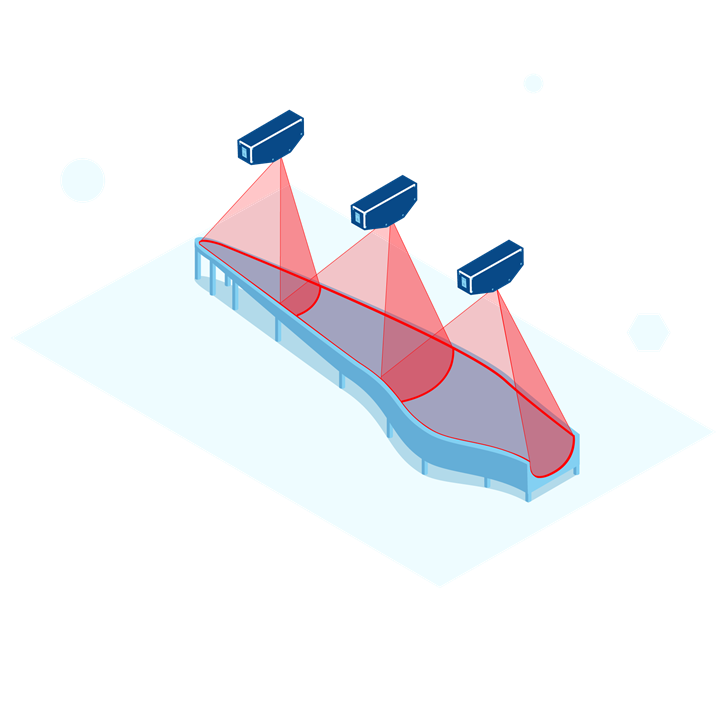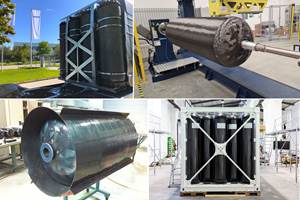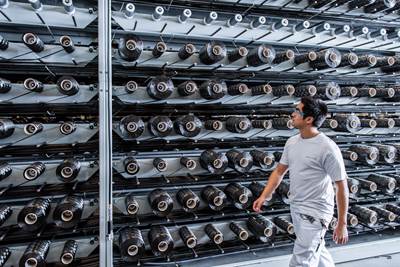
Photo Credit, all images: Z-Laser
In 2017, global wind power manufacturer Nordex Group (Hamburg, Germany) was tasked with developing an innovative, 74-meter-long composite rotor blade targeted at serial production, to be an expansion of its previous 50- and 65-meter blades. One challenge to the development process for the longer blade was accuracy; determination of the exact position for the glass fiber layup was very complex on a rotor blade of that length, and millimeter-range accuracy requirements were difficult to meet or time-consuming.
These challenges required Nordex Group to look for a new manufacturing process solution in order to produce the rotor blade both cost-effectively and with high quality standards.
After a three-month test phase, the company ultimately partnered with Z-Laser GmbH (Freiburg im Breisgau, Germany) to create a system using laser projection and positioning within the layup process to achieve its goals for faster production, shorter cycle times and greater precision.
The most time-consuming step in the production of a rotor blade is the layup of the glass fiber layers, which are divided into several patches in sizes up to 20 meters. Most of the material is used in the “root” area at the base of the blade, since this is where the greatest forces are experienced once the blade is put into operation. Therefore, small tolerances and high accuracy must also be observed while laying up this root area. In total, more than 200 individual glass fiber patches in 45 layers are laid up by hand to produce the blade.

Three of Z-Laser’s ZLP2 lasers are mounted above a rotor blade mold.
To optimize this process, Nordex Group first installed three of Z-Laser’s ZLP2 laser projectors onto the ceiling of the production facility, at a distance of 8 meters above the mold where the glass fiber layers are laid up. The projectors were positioned to cover approximately 90% of the mold for the suction-side blade (the section of the blade facing downwind), and 40% of the mold for the pressure-side blade (upwind). Operation is controlled via ZLP-Suite software, which was able to be easily integrated into Nordex customer applications using the product’s programming interface. The software is programmed by the user and may be extended on a modular basis.
During layup, the ZLP2 projects the exact positions onto the workpiece, so that hand layup can be done optimally and accurately. Excess material can then be removed along the laser mark so that it does not remain in the component. In addition to correct positioning of glass fiber layers, the laser projectors are also used to position prefabricated parts and core material inside the mold. “It is important for Nordex to always keep the same layup order of the glass fiber layers, and the correct overlapping from layer to layer,” notes Dr. Roland Fritz, sales manager of laser projectors at Z-Laser. “This ultimately has the effect of achieving an equal weight for each blade.”

Z-Laser’s ZLP2 laser projection system.
This first projection system was only the beginning, Z-Laser notes. The first ZLP2 laser projectors were installed by Nordex Group’s Rostock, Germany, location in January 2018 for the first mold, and in 2019 for the second mold. Additional projection systems were installed at the company’s Matamoros, Mexico, and Lumbier, Spain, factories. In 2021, further projector units have been shipped to Nordex Mexico and India facilities, with two more expected to be installed in India later this year. In total, more than 100 units will be installed.
According to Z-Laser, overall, the process saves up to three hours in the production process for a rotor blade with layup of more than 200 glass fiber layers. The company adds that its laser system is able to aid in manual layup processes with a relative degree of accuracy of 2 millimeters, and can enable dramatic cost reductions through time savings during the positioning process, reduced material waste and minimization of corrective work. The laser system also displays the work steps, minimizing training time for new employees.
“The technical maturity of the products and the technical expertise of Z-Laser were the deciding factors for us,” says Felix Bach, process engineer for blade technology at Nordex Group. “Even when timelines were tight, our collaboration with Z-Laser remained friendly and constructive. They delivered on what they promised 100%. The use of Z-Laser’s laser projection system has significantly reduced throughput times for the rotor blades while at the same time improving lamination quality. This means that we have come much closer to our goal of reducing process time to a minimum.”
Related Content
JEC World 2023 highlights: Recyclable resins, renewable energy solutions, award-winning automotive
CW technical editor Hannah Mason recaps some of the technology on display at JEC World, including natural, bio-based or recyclable materials solutions, innovative automotive and renewable energy components and more.
Read MoreUpdate: THOR project for industrialized, recyclable thermoplastic composite tanks for hydrogen storage
A look into the tape/liner materials, LATW/recycling processes, design software and new equipment toward commercialization of Type 4.5 tanks.
Read MoreDrag-based wind turbine design for higher energy capture
Claiming significantly higher power generation capacity than traditional blades, Xenecore aims to scale up its current monocoque, fan-shaped wind blades, made via compression molded carbon fiber/epoxy with I-beam ribs and microsphere structural foam.
Read MoreComposites end markets: Pressure vessels (2024)
The market for pressure vessels used to store zero-emission fuels is rapidly growing, with ongoing developments and commercialization of Type 3, 4 and 5 tanks.
Read MoreRead Next
GFRP trailing edge spoilers for rotor blades achieve 6% AEP increase
evoblade and Deutsche Windtechnik study confirms that the retrofittable Evoflap spoiler improves flow, offers load reduction and could potentially extend wind turbine service life.
Read MoreFiberline to supply carbon fiber profiles for Nordex Group wind blades
Denmark-based Fiberline says this transaction is its largest carbon fiber profile contract in the wind industry to date.
Read MoreDeveloping bonded composite repair for ships, offshore units
Bureau Veritas and industry partners issue guidelines and pave the way for certification via StrengthBond Offshore project.
Read More

.jpg;width=70;height=70;mode=crop)











.jpg;maxWidth=300;quality=90)








